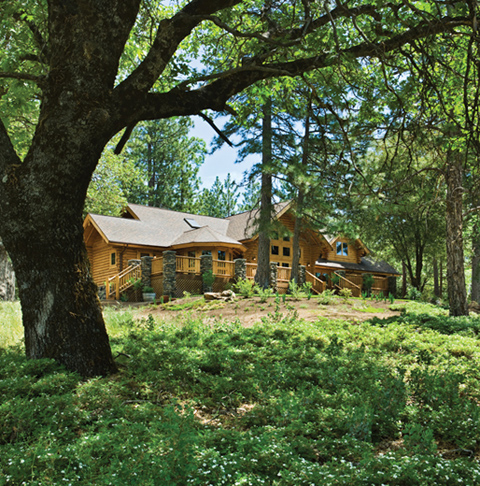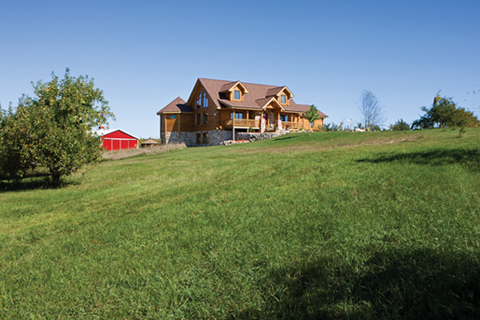Log homes have a nostalgic appeal for homeowners longing for a simpler life. And the relaxed, rustic feel of a log home seems right at home plopped in the middle of a grassy meadow, nestled in rolling hills, or tucked away in a thick forest. That’s country living, and many prospective log home owners today are yearning to build on a spread of land set apart from the busyness of American life as we know it today.
“The country’s the only place to live,” says Ed White, a sales representative for Honest Abe Log Homes, based in Moss, Tennessee. “Most people who are looking to build log homes want to get away from the hustle and bustle of city life. They want to step back, take life a little slower, and enjoy nature. Log homes offer the privacy, quiet, and calm they’re looking for.” Finding the perfect country retreat can take time. Here are a few tips on getting started.
Define Your Picture-Perfect Spot
Make a list of the property features that are important to you. Do you want to live far away from town and from other people? Or do you prefer to live rurally, with easy access to shopping, grocery stores, entertainment, and other activities you enjoy? Do you want a view? If so, what kind of view: a lake, mountains, or expansive plains? Think about the lifestyle you want to live and whether the property will allow you to achieve it.
 Photo by David Byron Keener
Photo by David Byron Keener“Make sure you’re buying land in an area close to all the things that would make your life rich and enjoyable,” says Allen Halcomb, architect and president of MossCreek in Knoxville, Tennessee.
Land Features and Terrain
For starters, select a parcel of land that’s the right size to accommodate the house you want. White recommends finding the property first and then designing your home to make sure it fits the land. Some properties fit a taller home with a compact footprint, while other sites may lend themselves to sprawling designs.
“Pick your property and then pick your home to fit it,” White says.
Take note of the slope of the land and consider how much buildable area it offers. If your land is steep or needs extensive clearing, be sure the budget can accommodate the extra expenses.
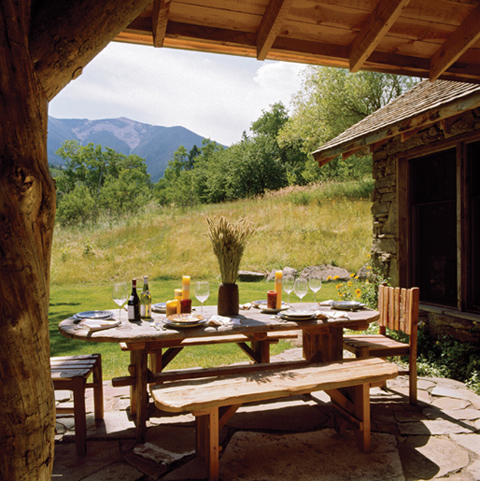 Miller Architects; Yellowstone Traditions/photo by Roger Wade.
Miller Architects; Yellowstone Traditions/photo by Roger Wade. “You could easily have a five-acre lot but only have about a quarter of an acre of buildable land,” says Halcomb. “The steeper property will be more difficult to build on. And difficult translates into expensive.”
Can You Get to the Property?
Rugged or steep terrain and other factors make some properties difficult to access. If that’s the case, you may have to spend a little more to make sure your log home producer will be able to deliver the log package and that other suppliers will be able to easily get to the house. Log home companies, for example, typically deliver logs on a 48-foot flatbed trailer. If your building site is unaccessible by such a large truck, you may need to make alternate arrangements for a drop point where a smaller truck can pick up the supplies and move them in smaller portions to the construction site.
Driveways, Easements, and Right-of-Way
Speaking of access, don’t forget to budget for a driveway. Consider early in the process what type of material you’ll want to use for your driveway and how long it will need to be to reach your house. And if your property is landlocked, or completely surrounded by property owned by others, you’ll need a way to get onto your property. Make sure your deed—and the deeds of the other property owners—ensures right-of-way access (or easement) for you to go across their property to get to your own. Otherwise, you’ll spend time and money working it out in a courtroom.
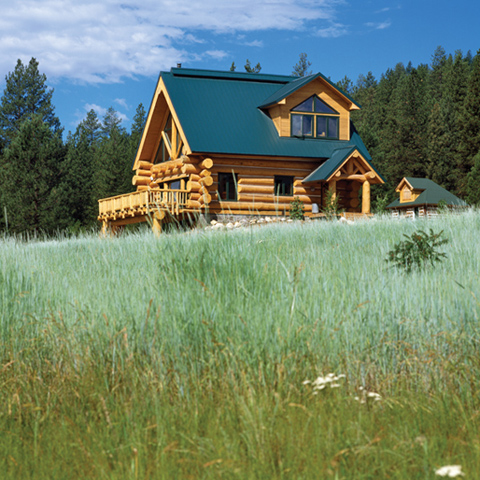 Pedersen Logsmiths/photo by Roger Wade
Pedersen Logsmiths/photo by Roger WadeWater and Septic Systems
Country homes typically are not connected to municipal water and sewer systems, so you’ll be responsible for making arrangements and paying for that access. Before construction begins, your local health department can do a percolation, or “perc,” test. This test determines the rate at which soil absorbs fluids within the septic drain field. If your property fails the perc test, then you won’t be able to build a septic system. There are alternative, above-ground systems you could consider, but these may be costly. Joel Robinson, president of Log Homes of America in Jefferson, North Carolina, recommends making your sales contract contingent on the property passing the perc test.
“We encourage our customers to make sure they have septic permits before finalizing their land purchase,” Robinson says. “Buying a lot doesn’t guarantee you’ll be able to get a septic permit, particularly on a smaller piece of property.”
As for water systems, Robinson recommends talking to well drillers in your area to determine the standard well depth for that region and whether water is difficult to find. Drill the well first, he says, so you’ll know how much money will be left for the overall budget.
“We encourage people to do well and septic early in the construction process, right after we do our site clearing and grading,” Robinson says. “You never know what you might run into that could make these elements end up costing more than you expected.”
Electricity, Internet, and Cable
Country living can be refreshing, but few people want to live off the grid. If your property isn’t wired for electricity, check your utility companies state-regulated fees for getting power to your property. The farther your house is from the main highway, the more you’ll have to pay for the electric service. White recalls a past customer whose home was seven miles off the main highway, making access to electricity too costly. Instead, the customer decided to power the home completely with solar energy. So there are alternatives, but you’ll want get accurate cost estimates before you start building.
Also, some areas don’t have access to high-speed Internet or cable service. If you plan to telecommute, that could impact your plans.
The Great Outdoors
While interior layout and design varies with personal taste, many homeowners living in the country want to incorporate outdoor living spaces that will maximize their enjoyment of their natural surroundings. Consider adding wraparound decks, screened-in porches, and outdoor kitchens where family and friends can gather and relax.
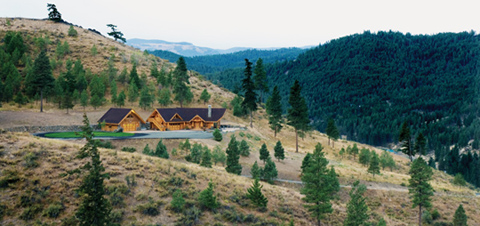 Photo by Heidi Long
Photo by Heidi LongTake Your Time
When it comes to building in the country, experts say you should be as laid-back as your new setting. Take your time and do your research—this magazine or our Web site (www.logcabins.com) are a great place to start. As you search for land, find the building company and the home design that best match your dreams. Ask questions and interview log home companies, designers, and builders carefully. Find folks you’re comfortable with and who have a proven track record.
“Hire people you feel confident you can trust,” Halcomb says. “Price is important, but trust is gold. You want people who will tell you the honest truth, even if it’s not comfortable. And if you’re not smiling, they’re not doing their job.”
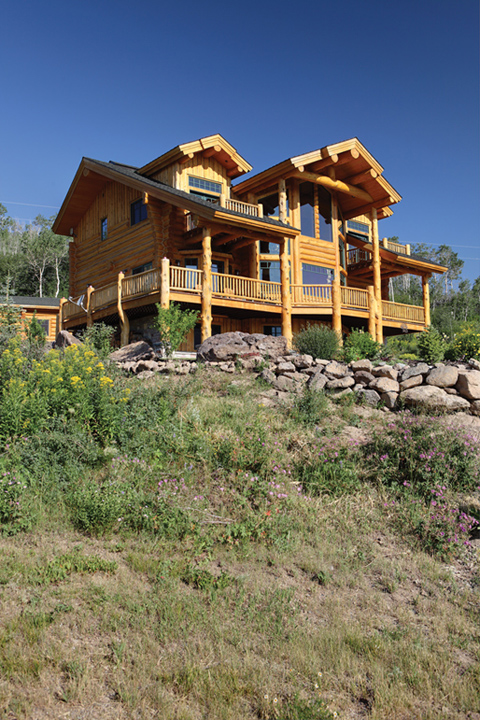 Photo by B Brown
Photo by B Brown

